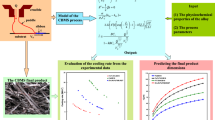Abstract
Experimental work on PFC performed with some amorphous alloys is reported. The subject of the investigation is the relationship between the main processing parameters and the resulting ribbon thickness. Calculations applying Bernoulli's equation reveal the relationship between the ribbon thickness and substrate velocity, ejection pressure, nozzle slot breadth and crucible wheel gap distance. Empirical data from numerous experiments are in good agreement with the calculations. Ribbons with smooth surfaces and precise cross-sections can be obtained by melt spinning with a small gap distance. The efficiency of a constrained melt puddle on the ribbon surface was exhibited by topographic measurements and high-speed motion pictures. Results of surface tension measurements have been used to explain the effect of the melt temperature on the ribbon thickness. Calculations and experimental data are a base for practical use of the PFC process in the production of ribbons with predetermined precise cross-section.
Similar content being viewed by others
References
J. H. Vincent, J. G. Herbertson and H. A. Davis, Proceedings of the 4th International Conference on Rapidly Quenched Metals, Sendai 1981, Vol. I (The Japanese Institute of Metals, Sendai, 1982) p. 77.
H. H. Liebermann and C. D. Graham Jr, IEEE Trans. Magn. MAG-12 (1976) 921.
H. H. Liebermann, Mater. Sci. Eng. 43 (1980) 203.
S. Kavesh, “Metallic Glasses” (ASM, Metals Park, Ohio, 1978) p. 275.
H. A. Davies, in “Rapidly Quenched Metals III”, Vol. I (The Metals Society, London, 1978) p. 1.
H. H. Hillmann and H. R. Hilzinger, ibid.in p. 22.
D. Pavuna, J. Mater. Sci. 16 (1981) 2419.
M. C. Narasimhan, US Patent 4 142 571 (1979).
S. Takayama and T. Oi, J. Appl. Phys. 50 (1979) 1595, 4962.
S. C. Huang, General Electric Report No. 81 CRD 152 (1981).
S. C. Huang and H. C. Fiedler, Met. Trans. A 12A (1981) 1107.
W. Jaschinski, W. Wolf, U. König and J. Hartwig, Techn. Mitt. Krupp, Forsch. Ber. 39 (1981) 1.
H. E. Cline and T. R. Anthony, General Electric Report No. 78 CRD 066 (1978).
H. Fiedler and L. Illgen, Proceedings, 14 Metalltagung in der DDR, Akademie der Wissenschaften der DDR (Zentralinstitut für Festkörperphysik und Werkstofforschung, Dresden, 1981) p. 72.
R. Schroedinger, Ann. Physik 46 (1915) 413.
W. Albring, “Angewandte Strömungslehre” (Verlag Theodor Steinkopff, Dresden, 1966).
V. P. Ovčarov, unpublished results, Moscow (1981).
Author information
Authors and Affiliations
Rights and permissions
About this article
Cite this article
Fiedler, H., Mühlbach, H. & Stephani, G. The effect of the main processing parameters on the geometry of amorphous metal ribbons during planar flow casting (PFC). J Mater Sci 19, 3229–3235 (1984). https://doi.org/10.1007/BF00549809
Received:
Accepted:
Issue Date:
DOI: https://doi.org/10.1007/BF00549809




